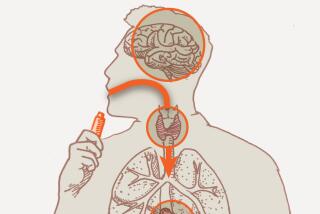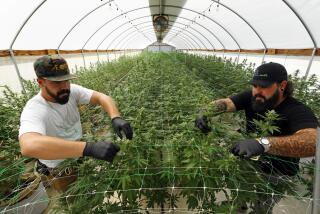One drug, two takes
- Share via
As assistant district attorney in San Francisco, Keith Vines prosecuted one of the largest illicit drug busts the city had ever seen. Then he came down with AIDS wasting syndrome and lost 60 pounds over three years.
To stimulate his appetite, he started taking marinol, an FDA-approved drug containing THC, one of the active ingredients in marijuana. He says he couldn’t control the dose of the drug, which must be swallowed. “I would be out of it for four or five hours,” he says.
For the record:
12:00 a.m. May 4, 2006 For The Record
Los Angeles Times Thursday May 04, 2006 Home Edition Main News Part A Page 2 National Desk 2 inches; 97 words Type of Material: Correction
Medical marijuana: An article in Monday’s Health section about medical marijuana said the drug’s active compounds pass through the liver when smoked but not when swallowed. In fact, the reverse is true: When swallowed, the chemicals travel to the liver from the stomach. When inhaled, chemicals do reach the liver, but in smaller amounts. The article also referred to doctors as “prescribing” the drug for medical use. Technically, in states where medical use of marijuana is legal, doctors cannot prescribe it. Instead, in California they write “recommendations” for patients, who can then legally obtain or grow it.
For The Record
Los Angeles Times Monday May 08, 2006 Home Edition Health Part F Page 21 Features Desk 3 inches; 102 words Type of Material: Correction
Medical marijuana: An article in last week’s Health section on medical marijuana said the drug’s active compounds passed through the liver when smoked but not when they are swallowed. In fact, the reverse is true: When swallowed, the chemicals travel straight to the liver from the stomach. When inhaled, chemicals do get to the liver, but in lowered amounts. The article also referred to doctors as “prescribing” marijuana for medical use. Technically, in states where medical use of marijuana is legal, doctors cannot prescribe it. Instead, in California, they write “recommendations” for patients, who can then legally obtain it or grow it.
And so, instead of continuing with marinol, he started smoking medical marijuana, keeping his head clear by puffing only as much as he needed to get hungry. He gained back all his weight, he says.
Like many in his condition, Vines flatly disagrees with an April 20 announcement by the Food and Drug Administration and several other federal agencies that smoking marijuana confers no medical benefits.
So do physicians who write prescriptions for medical marijuana. (Doctors can’t prescribe the plant.) They say the government hasn’t done its homework -- and cite a 1999 report by the Institute of Medicine, a prestigious organization that advises the government, that found otherwise.
That 1999 report concluded that smoked marijuana could stimulate appetite in some patients with AIDS wasting disease; lessen nausea and vomiting caused by chemotherapy for cancer; and alleviate pain.
“I’m disappointed that they haven’t really read the research or spoken with people in the field,” says Los Angeles internist Dr. Eve H. Elting, who recommends medical marijuana to treat patients with chronic pain due to cancer and injuries; nausea and vomiting caused by chemotherapy; and migraines.
“The FDA statement directly opposes what the [Institute of Medicine] said,” says Dr. Jean Talleyrand of Ukiah, who also recommends medical marijuana. “My first question is, how did they come to that conclusion?”
Some scientists involved in crafting the 1999 report were more circumspect.
“I thought there was pretty good agreement among the panel that THC has good benefit, and it’s in marijuana,” says Billy R. Martin, a professor of pharmacology and toxicology at Virginia Commonwealth University.
But, he adds, “when you turn to the FDA, they require well-controlled studies showing efficacy.”
Martin says in many ways the tussle between federal agencies such as the FDA and medical marijuana proponents boils down to politics -- on both sides.
“I’m sad, but I don’t think science is a factor,” he says.
Dr. Howard Fields, a professor of neurology and psychology at UC San Francisco and another panel member, agrees. “There is so much distortion of the research on both ends of the spectrum,” he says.
FDA’s statement
According to FDA spokeswoman Kathleen Quinn, the agency’s decision to issue a statement about marijuana was prompted by inquiries from individuals and members of Congress who were curious about “recent reports [that] have suggested that smoked marijuana may offer pain relief for [some] conditions,” she wrote in an e-mail.
The FDA, she added, drew upon “the latest formal scientific evaluation of the government” of marijuana -- a 2001 Drug Enforcement Agency report.
Some doctors and scientists say they trust science over drug laws. Scientists outside of law enforcement crafted the Institute of Medicine report. To write it, Martin, Fields and nine other clinical and basic researchers perused hundreds of studies on marijuana, consulted biomedical and social researchers in the field, held workshops with medical marijuana patients, and visited HIV/AIDS clinics.
The result was neither a blanket endorsement nor an utter dismissal of medical marijuana use -- but something in-between.
Some of the studies, the scientists found, lend support for Vines’ experience with marinol and marijuana. Marinol pills release their contents slowly, taking 2.5 hours to maximize their levels in blood. Smoking delivers the chemicals in 2.5 minutes.
In addition, studies show that the chemicals delivered to the body differ, depending on whether marijuana’s active compounds travel through the stomach (as they do when swallowed) or the liver (as they do when smoked).
“There’s less of a psychoactive chemical when you inhale it,” says Dr. Donald I. Abrams, a professor of hematology and oncology at UC San Francisco, who was not a member of the panel.
The report also points out that some chemotherapy patients would not be able to keep down pills long enough for the drugs to take effect.
“No doubt about it. Marijuana smoke is a great way to deliver drugs,” says Martin.
The scientists also looked at few studies that tested the ability of THC-related compounds to quell chronic pain due to cancer or nerve damage.
For example, in one 1975 study, researchers gave either placebos or THC pills in a range of doses to 10 cancer pain patients averaging 51 years of age. They found that higher doses quelled the pain significantly.
Glaucoma patients have long valued marijuana’s medicinal properties of reducing internal pressure of the eye. Such pressure can eventually cause blindness.
But Martin says the panel didn’t recommend marijuana for glaucoma because the connection between eye pressure and nerve damage is not clear, and studies hadn’t addressed whether marijuana is safe for the optic nerve.
Although eight studies which gauged eye measurements in people taking marijuana or THC support the idea that marijuana can reduce eyeball pressure, clinical studies are only now underway to test the effects of the drug more closely.
For nausea, the panel examined about a dozen studies that looked at THC or marijuana’s ability to quell nausea during chemotherapy. For example, in one study, 56 cancer patients who did not respond to other anti-nausea and vomiting drugs were given marijuana. More than one-third rated the plant as moderately or highly effective.
The report pointed out, however, that these studies weren’t well controlled -- and controls, Martin says, are especially important in studying smoked marijuana. “There are a fair number of learned behaviors with marijuana -- such as expecting to feel good,” he says.
The report also stated that the benefits of smoking the plant must be weighed against the potential harm in the smoke. Marijuana smoke contains some of the same hazardous chemicals found in cigarette smoke.
Scientists say that there is no conclusive evidence that smoking marijuana causes cancer in people. Still, because of the potential carcinogenicity, the American Cancer Society does not advocate the use of inhaled marijuana or the legalization of marijuana, while agreeing that THC and cannabinoids in marijuana will help alleviate some symptoms, says ACS spokesman David Sampson.
Nonsmoking options
There could be ways to mitigate that risk. Both the Institute of Medicine report and the Drug Enforcement Agency report used by the FDA recommended that alternatives to smoking marijuana cigarettes be developed.
They cited vaporizers, available to medical marijuana users these days, that “toast” marijuana rather than burn it.
This lets the volatile THC and other active compounds escape the plant for inhalation, leaving behind some of the toxic chemicals, such as benzene and toluene. The appliances, however, can cost 20 times that of a conventional marijuana pipe.
In the midst of the impassioned debate, a lot of people overlook the fact that THC (although not marijuana’s other active ingredients) is available in pill form, Fields says. The pain relief offered by marinol is comparable to that of aspirin, he says, “so why would anyone want to use cannabis?”
Fields does think that there are some people who could benefit from smoking marijuana. And Vines, for whom marinol did not work, says the government could erase many of the problems associated with medical marijuana use by altering its legal status so the drug can be obtained -- but by prescription only.
“You can’t help but scratch your head and wonder what the government is doing,” he says.
More to Read
Sign up for Essential California
The most important California stories and recommendations in your inbox every morning.
You may occasionally receive promotional content from the Los Angeles Times.










